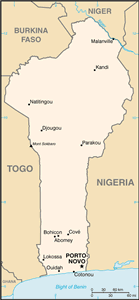The Geography of Benin
The Geography of Benin
Beninese Geography
Location: Western Africa, bordering the Bight of Benin, between Nigeria and Togo
Geographic coordinates: 9 30 N, 2 15 E
Map references: Africa
Area: total: 112,620 sq km land: 110,620 sq km water: 2,000 sq km
Area - comparative: slightly smaller than Pennsylvania
Land boundaries: total: 1,989 km border countries: Burkina Faso 306 km, Niger 266 km, Nigeria 773 km, Togo 644 km
Coastline: 121 km
Maritime claims: territorial sea: 200 nm
Climate: tropical; hot, humid in south; semiarid in north
Terrain: mostly flat to undulating plain; some hills and low mountains
Elevation extremes: lowest point: Atlantic Ocean 0 m highest point: Mont Sokbaro 658 m
Natural resources: small offshore oil deposits, limestone, marble, timber
Land use: arable land: 23.53% permanent crops: 2.37% other: 74.1% (2005)
Irrigated land: 120 sq km (2003)
Natural hazards: hot, dry, dusty harmattan wind may affect north from December to March
Environment - current issues: inadequate supplies of potable water; poaching threatens wildlife populations; deforestation; desertification
Environment - international agreements: party to: Biodiversity, Climate Change, Climate Change-Kyoto Protocol, Desertification, Endangered Species, Environmental Modification, Hazardous Wastes, Law of the Sea, Ozone Layer Protection, Ship Pollution, Wetlands, Whaling signed, but not ratified: none of the selected agreements
Geography - note: sandbanks create difficult access to a coast with no natural harbors, river mouths, or islands


